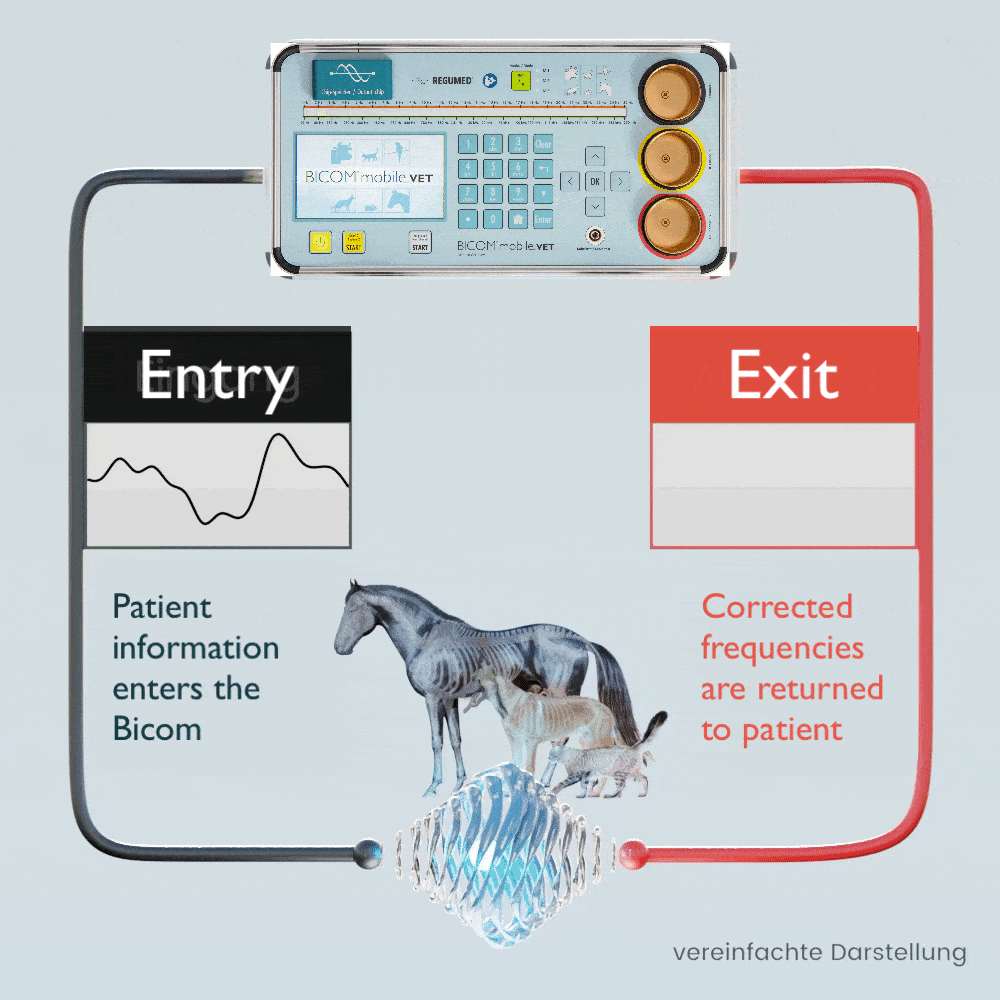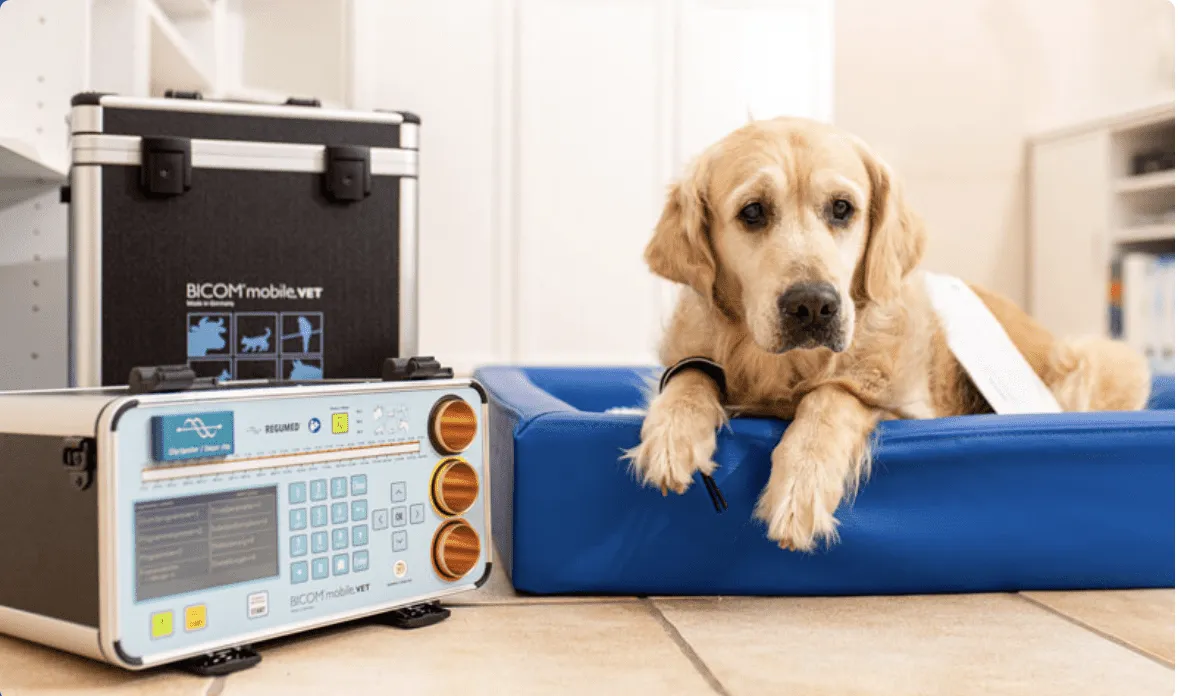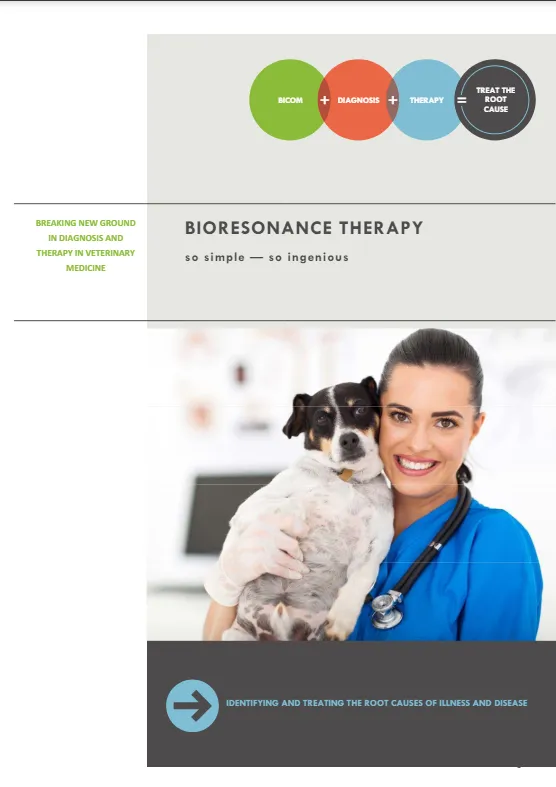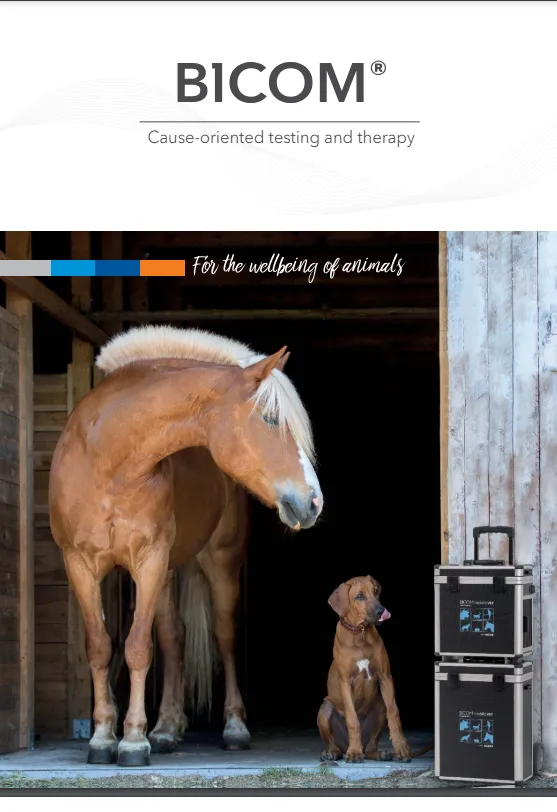Treatment with the help of the patient’s own information
in the BICOM® mobile VET bioresonance device
In contrast to other “frequency therapy devices”, BICOM® bioresonance is a method that is highly individual and perfectly tailored to the needs of the patient through the use of the patient’s own information and the possibility of testing specific wave patterns for resonance.
The patient’s own pathological and physiological information is recorded using special applicators and fed into the BICOM® mobile VET.
Depending on the therapy program, the specific wave pattern as a carrier of information is amplified, weakened or inverted and transmitted back to the patient in modulated form, which means that the transmission of information changes in clarity depending on the modulation or it disappears completely.
The treatment signals continuously adapt to the changing pathological situation of the patient. As the therapy progresses, the body’s ability to regulate is reactivated.
Find out more about this topic at our regular events. Together with veterinarians and animal naturopaths, we offer various face-to-face and online events .
The BICOM® bioresonance method is a cause-oriented, holistic treatment concept. It can narrow down the cause of the health problem in animals and find out even the hidden causes of the clinical picture.
Animals have a natural regulatory system that can also compensate for unusual influences. However, even good self-healing powers eventually reach their limits. Persistent exposure to allergens, environmental toxins, fungi, viruses, bacteria or stress and changed living conditions weaken the immune system and are often the cause of an illness. In particular, fungal infestation on the skin or chronic diseases in general are not always due to a breeding-related genetic defect, but are signs of a disturbed immune system.
The BICOM® bioresonance method is the key to successful diagnosis and therapy, especially for animals that cannot tell us exactly where it hurts or what the symptoms are. It is a gentle form of therapy that can be carried out without side effects and without additional stress for the animal.
The BICOM® mobile VET records the bioenergetic state of the animal, processes the information it contains and returns modified vibrations / therapy frequency patterns to the animal. Symptoms and stress can be diagnosed and targeted therapy can be initiated.
Through the use of endogenous and exogenous substances, the body’s own self-healing powers can be activated and imbalances that have existed for a long time can also be regulated.
REGUMED Medizintechnik are pioneers of the BICOM® bioresonance method. More than 30,000 therapists worldwide, well over 10,000 of them in Germany, successfully use their therapy concept.

Biophysical basics of the bioresonance method
Life is only possible when three conditions are met: matter, energy and information.
We also find these aspects in conventional medicine, both in diagnostics and in therapy. For example, every drug is also a carrier of information.
Information is neither energy nor matter, it is immaterial and comparable to the meaning of a message from a sending to a receiving system.
In addition to the electrical processes in the receptor proteins and biomembranes in general, electromagnetic interactions through light (biophotons) also play a role in cell communication and the transmission of information.
Specific electromagnetic wave patterns act as information carriers. These wave patterns can be modulated by the BICOM® device in order to eliminate disturbing or stressful information in an organism.
The goal is to restore the free flow of healing information (cell communication) and thus support the self-regulation of the organism and the self-healing powers.
Individual, patient-specific information or information from native substances, digitized substances or information stored on storage media can be used for therapy.
What your colleagues are saying…

Bioresonance Allergy Treatment Explained Clearly
Bioresonance Allergy Treatment: What You Need to Know
What Is Bioresonance Allergy Treatment?
Bioresonance allergy treatment is a non-invasive technique that aims to assess and correct imbalances in the body’s energy field that may be caused by allergens. It’s based on the theory that each cell in the body emits its electromagnetic frequency. When exposed to substances like pollen, food, or chemicals, these natural frequencies can become distorted, leading to allergic responses.
This method uses specialized devices that measure these frequencies through sensors placed on the skin. The machine identifies irregular patterns and sends corrective frequencies back to the body to neutralize the impact of allergens. While it doesn't cure allergies, many people find it helpful in reducing the intensity and frequency of their symptoms.
Traditional allergy tests, such as skin prick or blood tests, only measure specific antibodies. They often miss broader sensitivities that cause reactions but don’t register on conventional diagnostics. Bioresonance aims to fill that gap by examining the body's energetic response.
How Bioresonance Allergy Treatment Works
The session begins with a consultation where the practitioner reviews your medical history, symptoms, and lifestyle. Electrodes are attached to the hands or feet, which are connected to a bioresonance machine. The device scans the body’s energetic field for disturbances caused by allergens.
When irregular frequencies are found, the machine emits mirror-image signals intended to neutralize the effects of these allergens. Think of it as "canceling out" the allergen's disruptive frequency. These signals are gentle and safe, and most people don’t feel anything during the session.
The aim is not to treat the allergy directly but to improve the body’s energetic balance so it can handle allergens more efficiently. Depending on the individual, a series of sessions may be required for long-term effects.
What Types of Allergies Can It Help With?
Bioresonance allergy treatment is used to support individuals suffering from a wide range of sensitivities and allergic responses. These include:
Seasonal allergies: Pollen from trees, grasses, and weeds
Food sensitivities: Dairy, gluten, soy, shellfish, and preservatives
Environmental irritants: Dust mites, mold spores, smoke
Chemical triggers: Fragrances, cleaning agents, pesticides
Animal-related reactions: Pet dander from cats, dogs, horses
Many patients who suffer from “hidden allergies” or those that don’t show up in standard tests often find value in this method. It can also be used for intolerances that develop gradually and fluctuate with stress, diet, or hormonal changes.
Scientific Overview and Available Research
Although bioresonance therapy is widely used in parts of Europe and Asia, it remains a controversial topic in mainstream Western medicine. A major reason is the lack of large-scale, controlled studies.
That said, several smaller studies and case reports provide promising data:
A 2014 trial in Switzerland observed children with hay fever symptoms who underwent eight weeks of bioresonance sessions. Over 70% reported improvement in sleep, nasal congestion, and eye irritation.
A German study from 2015 compared bioresonance therapy to a placebo in adults with digestive-related food sensitivities. The group receiving bioresonance showed a 60% symptom reduction, while the placebo group showed minimal change.
In clinical settings in Austria, practitioners have reported success with bioresonance in supporting children with eczema linked to food triggers.
Though these results are encouraging, most were not double-blind or replicated across large populations. That limits their reliability in the eyes of conventional healthcare providers. More standardized research is needed before this therapy can be fully accepted in clinical practice.
Ideal Candidates for This Therapy
Not everyone responds the same way to bioresonance allergy treatment. However, some individuals may find it particularly beneficial:
People who prefer natural or alternative therapies over medication
Children or adults with anxiety about needles or invasive tests
Those with chronic, unexplained symptoms despite negative allergy tests
Individuals sensitive to multiple foods or environmental triggers
Patients interested in a broader, holistic look at their health
It’s essential to remember that this treatment should not replace urgent care for severe allergic reactions. Anaphylaxis or other life-threatening conditions require immediate medical attention.
What Happens During a Typical Session?
Sessions are usually conducted in a quiet therapy room. After a thorough health review, the therapist will attach electrodes to your skin. These sensors relay information to the bioresonance device.
During the session, the machine scans your body’s energetic responses to a series of potential allergens. This may include food extracts, pollen, dust, animal hair, and more. The device then sends out frequencies to help balance the body’s reaction to those specific allergens.
Most people feel relaxed during the procedure. The process is gentle, painless, and does not involve any skin penetration, needles, or medications. Some clients report feeling a sensation of warmth or tingling, but many feel nothing at all.
Short-Term and Long-Term Effects
Some people notice immediate relief, especially if their symptoms are mild. Others experience gradual improvement over several sessions. Common short-term effects may include:
A feeling of fatigue or light-headedness for a few hours
Increased thirst or urination as the body clears toxins
Temporary worsening of symptoms (a “healing response”)
Over time, many clients report a reduction in:
Sneezing, coughing, and watery eyes
Digestive discomfort after eating certain foods
Skin issues like eczema or hives
Headaches or fatigue triggered by allergens
Potential Risks and Side Effects
Since bioresonance allergy treatment does not involve drugs or chemicals, the risk of serious side effects is very low. However, some individuals may experience temporary discomfort as their body adjusts. These reactions are usually mild and short-lived:
Headache
Mild nausea
Skin flushing or itchiness
Emotional sensitivity
These are often interpreted by practitioners as signs that the body is responding to energetic shifts. Drinking water and resting after a session can help ease these effects.
How Much Does It Cost?
Prices for bioresonance allergy treatment vary based on your location and the practitioner’s qualifications. In general:
Initial session (including consultation): $100–$150
Follow-up sessions: $60–$100
Packages (5 to 10 sessions): Discounts are often available
Since this therapy is not widely recognized by mainstream medical systems, insurance may not cover it. Be sure to clarify payment policies in advance.
Choosing a Reliable Practitioner
It’s important to choose a qualified and experienced practitioner. Since bioresonance is not strictly regulated in all regions, take the following steps:
Ask about certifications or training in bioresonance
Inquire about the type of equipment used
Look for practitioners with positive reviews and client testimonials
Make sure they explain the process clearly and answer your questions
Check that their practice follows hygiene and safety standards
Choosing the right person increases your chances of a comfortable experience and better outcomes.
FAQs
1. What happens during a session?
You’ll sit comfortably while electrodes read your body’s response to various allergens. The device then sends balancing signals to reduce sensitivity.
2. Is the therapy safe for children?
Yes, it’s non-invasive and gentle, making it suitable for kids who have allergy-like symptoms without clear causes.
3. How many sessions are usually needed?
Most people start with 3 to 6 sessions, but the number can vary depending on symptom severity and response rate.
4. Can I use this method alongside medication?
Yes, but always inform your healthcare provider. It’s often used as a complementary option rather than a replacement.
5. Are the results permanent?
Some people experience long-term relief, while others may need occasional follow-ups, especially if new sensitivities arise.
Conclusion
Bioresonance allergy treatment is gaining popularity as a non-invasive option for identifying and reducing sensitivities. While scientific backing is still growing, many people report real improvements in their symptoms, especially when traditional approaches haven’t worked.
This method offers a unique way to look at allergies—not just as physical reactions, but as signals of energetic imbalance in the body. With a qualified therapist, supportive environment, and clear expectations, it can become a helpful part of your wellness journey.
If you're curious about alternative approaches and have ongoing allergy-related discomfort, this gentle therapy may offer the support you’ve been seeking.
Treatment Priorities
For gentle and optimal treatment of the causes of diseases in animals
The BICOM® bioresonance method is predestined for use with large and farm animals such as horses , but also with dogs , cats and small animals. The treatment focus of the BICOM® mobile VET is wide-ranging. It is now used for many indications.
It recognises health deficits at an early stage and is used, among other things, for the following symptoms:
sweet itch
Feed intolerances
allergies and related diseases
COB/COPD
leishmaniasis
Lyme disease
anaplasmosis
lameness in horses
hoof ulcer
Poisoning by poisoned baits, plants etc.
mauke
Feline infectious peritonitis (FIP)
Cat flu/cat disease
eye/conjunctivitis
and much more
Get advice now!
Our experts are happy to be there for you personally
Our BICOM® bioresonance experts are available to answer any questions you may have
and will be happy to advise you personally and individually.




Request more information
Quick Links





Facebook
Instagram
Mail